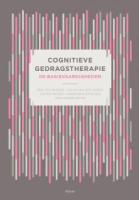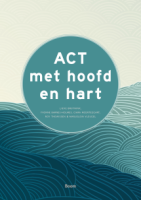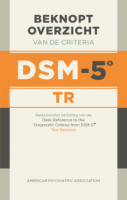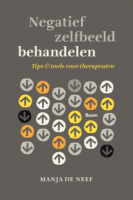Inhoud
Nieuwe ontwikkelingen in de gedragstherapie voor de obsessieve-compulsieve stoornis
Samenvatting
CGT is de afgelopen 30 jaar uitgegroeid tot een effectieve behandeling voor OCS. Desondanks blijft er een groep patiënten bestaan die uitvalt tijdens de behandeling of onvoldoende respondeert. Dit heeft er de afgelopen decennia toe geleid dat er is gezocht naar mogelijkheden om de behandeling te verbeteren. Enerzijds heeft dit geleid tot ontwikkelingen binnen het cognitieve model van OCS en anderzijds tot de ontwikkeling van biologische behandeling in combinatie met CGT.
De ontwikkelingen binnen het cognitieve model, MCT en IBA, lijken variaties te zijn op thema’s die binnen de reguliere CGT als bekend worden verondersteld en dat maakt ze minder vernieuwend. Wellicht mag worden aangenomen dat binnen expertisecentra deze methodes geïntegreerd zijn in de reguliere CGT. Er is vrij weinig onderzoek naar de effectiviteit van beide behandelmethodes, terwijl beide methodes al meer dan een decennium in ontwikkeling zijn. Op basis van huidig doch beperkt wetenschappelijk onderzoek lijken zowel MCT als IBA effectieve behandelingen voor OCS. Gezien het ontbreken van goed uitgevoerd onderzoek in de vorm van RCT’s kan er momenteel echter niet worden aangetoond dat zij effectiever zijn dan reguliere CGT. Ons inziens zou toekomstig onderzoek zich moeten richten op het optimaliseren van de huidige evidence-based CGT. Toevoeging van biologische therapieën als D-cycloserine en diepe hersenstimulatie lijkt daarbij perspectief te bieden en biedt hoop aan patiënten die tot op heden niet met de reguliere behandelmethodes geholpen kunnen worden.
Literatuur
- Aardema, F., O'Connor, K.P., Emmelkamp, P.M., Marchand, A., & Todorov, C. (2005). Inferential confusion in obsessive-compulsive disorder: the inferential confusion questionnaire. Behaviour Research and Therapy 43, 293-308.
- Abramowitz, J.S. (2006). The psychological treatment of obsessive-compulsive disorder. Canadian Journal of Psychiatry, 51, 407-416.
- Andouz, Z., Dolatshahi, B., Moshtagh, N., & Dadkhah, A. (2012). The efficacy of metacognitive therapy on patients suffering from pure obsession. Iranian Journal Psychiatry J.Psychiatry, 7, 11-21.
- Balkom A.J. van, De Haan E., van Oppen P., Spinhoven P., Hoogduin K.A., & Dyck R. van (1998). Cognitive and behavioral therapies alone versus in combination with fluvoxamine in the treatment of obsessive compulsive disorder. The Journal of Nervous and Mental Disease, 186(8), 492-9.
- Cottraux, J., Note, I., Yao, S N., Lafont, S., Note, B., Mollard, E. et al. (2001). A randomized controlled trial of cognitive therapy versus intensive behavior therapy in obsessive compulsive disorder. Psychotherapy and Psychosomatics, 70, 288-297.
- Craske, M.G., Kircanski, K., Zelikowsky, M., Mystkowski, J., Chowdhury, N., & Baker, A. (2008). Optimizing inhibitory learning during exposure therapy. Behaviour Research and Therapy, 46, 5-27.
- Denys, D. (2006). Pharmacotherapy of obsessive-compulsive disorder and obsessive compulsive spectrum disorders. Psychiatric Clinics of North America , 29, 553-84,.
- Denys, D., Mantione, M., Figee, M., Munckhof, P. van den, Koerselman, F., Westenberg, H. et al. (2010). Deep brain stimulation of the nucleus accumbens for treatment-refractory obsessive-compulsive disorder. Archives of General Psychiatry, 67, 1061-1068.
- Fals-Stewart, W., Marks, A.P., & Schafer, J. (1993). A comparison of behavioral group therapy and individual behavior therapy in treating obsessive-compulsive disorder. Journal of Nervous and Mental Disease, 181, 189-193.
- Figee, M., Luigjes, J., Smolders, R., Valencia-Alfonso, C.E., Wingen, G. van, Kwaasteniet, B., Mantione, M., Ooms, P., Vulink, N., Levar, N., Droge, L., van den Munckhof, P., Schuurman, R., Nederveen, A., van den Brink, W., Mazaheri, A., Vink, M., Denys, D. (2013). Deep brain stimulation restores frontostriatal network activity in obsessivecompulsive disorder. Nature Neuroscience, 16, 386–387.
- Fisher, P.L., & Wells, A. (2005). How effective are cognitive and behavioral treatments for obsessive-compulsive disorder? A clinical significance analysis. Behaviour Research and Therapy, 43, 1543-1558.
- Fisher, P.L., & Wells, A. (2005). Experimental modification of beliefs in obsessive-compulsive disorder: a test of the metacognitive model. Behaviour Research and Therapy, 43, 821-829.
- Fisher, P.L., & Wells, A. (2008). Metacognitive therapy for obsessive-compulsive disorder: a case series. Journal of Behavior Therapy and Experimental Psychiatry, 39, 117-132.
- Foa, E.B., Liebowitz, M.R., Kozak, M.J., Davies, S., Campeas, R., Franklin, M.E. et al. (2005). Randomized, placebo-controlled trial of exposure and ritual prevention, clomipramine, and their combination in the treatment of obsessive-compulsive disorder. American Journal of Psychiatry, 162, 151-161.
- Franklin, M.E., Abramowitz, J.S., Kozak, M.J., Levitt, J.T., & Foa, E.B. (2000). Effectiveness of exposure and ritual prevention for obsessive-compulsive disorder: randomized compared with nonrandomized samples. Journal of Consulting and Clinical Psychology, 68, 594-602.
- Freeston, M.H., Leger, E., & Ladouceur, R. (2001) Cognitive therapy of obsessive thoughts. Cognitive and Behavioral Practice, 8(1), 61–78 Goodman, W.K., Price, L.H., Rasmussen, S.A., Mazure, C., Fleischmann, R.L., Hill, C.L. et al. (1989). The Yale-Brown Obsessive Compulsive Scale. I. Development, use, and reliability. Archives of General Psychiatry, 46, 1006-1011.
- Goodman, W.K., Price, L.H., Rasmussen, S.A., Mazure, C., Delgado, P., Heninger, G.R. et al. (1989). The Yale-Brown Obsessive Compulsive Scale. II. Validity. Archives of General Psychiatry, 46, 1012-1016.
- Goodman, W.K., Foote, K.D., Greenberg, B.D., Ricciuti, N., Bauer, R., Ward, H. et al. (2010). Deep brain stimulation for intractable obsessive compulsive disorder: pilot study using a blinded, staggered-onset design. Biological Psychiatry, 67, 535-542.
- Greenberg, B.D., Malone, D.A., Friehs, G.M., Rezai, A.R., Kubu, C.S., Malloy, P.F. et al. (2006). Three-year outcomes in deep brain stimulation for highly resistant obsessive-compulsive disorder. Neuropsychopharmacology, 31, 2384-2393.
- Guastella, A.J., Richardson R., Lovibond, P.F., Rapee, R.M., Gaston, J.E., Mitchell P., & Dadds M.R. (2007): A randomised controlled trial of d-cycloserine enhancement of exposure therapy for social phobia. Biological Psychiatry, 63, 544 –549.
- Hofmann S.G., Meuret A.E., Smits J.A., Simon N.M., Pollack M.H., & Eisenmenger K. (2006): Augmentation of exposure therapy with d-cycloserine for social anxiety disorder. Archives of General Psychiatry, 63, 298 –304.
- Huff, W., Lenartz, D., Schormann, M., Lee, S. H., Kuhn, J., Koulousakis, A. et al. (2010). Unilateral deep brain stimulation of the nucleus accumbens in patients with treatmentresistant obsessive-compulsive disorder: Outcomes after one year. Clinical Neurology and Neurosurgery, 112, 137-143.
- Koning, P.P. de, Figee, M., Munckhof, P. van den, Schuurman, P.R., & Denys, D. (2011). Current status of deep brain stimulation for obsessive-compulsive disorder: a clinical review of different targets. Current Psychiatry Reports, 13, 274-282.
- Kozak M.J., & Foa E.B. (1997). Mastery of obsessive compulsive disorder: A cognitive behavioural approach. San Antonio: psychological Corporation.
- Kushner, M.G., Kim, S.W., Donahue, C., Thuras, P., Adson, D., Kotlyar, M. et al. (2007). d-cycloserine augmented exposure therapy for obsessive-compulsive disorder. Biological Psychiatry, 62, 835-838.
- Lindsay, M., Crino, R., & Andrews, G. (1997). Controlled trial of exposure and response prevention in obsessive-compulsive disorder. The British Journal of Psychiatry,, 171, 135-139.
- Mallet, L., Polosan, M., Jaafari, N., Baup, N., Welter, M.L., Fontaine, D. et al. (2008). Subthalamic nucleus stimulation in severe obsessive-compulsive disorder. The New England Journal of Medicine., 359, 2121-2134.
- Mantione, M., Figee M., & Denys D. (2011) Diepe hersenstimulatie voor therapierefractaire obsessieve-compulsieve stoornis. In van Balkom A.J.L.M., Oosterbaan D., Visser S., van Vliet I.M..(Ed.), Handboek Angststoornissen. Utrecht: De Tijdstroom, 431- 443.
- Mantione M., Nieman D., Figee M., Schuurman P., Munckhof P. van den, & Denys D. Cognitive behaviour therapy augments the effects of deep brain stimulation in obsessive-compulsive disorder. Submitted.
- March, J.S., Frances A., Kahn, D.A., & Carpenter D. (1997). The expert consensus guideline series: treatment of obsessive–compulsive disorder. Journal of Clinical Psychiatry,58(4), 5–71.
- McIntyre, C.C., Savasta, M., Walter, B.L., & Vitek, J.L. (2004). How does deep brain stimulation work? Present understanding and future questions. Journal of Clinical Neurophysiology, 21, 40-50.
- Mataix-Cols, D., Marks, I.M., Greist, J.H., Kobak, K.A., & Baer, L. (2002). Obsessive-compulsive symptom dimensions as predictors of compliance with and response to behaviour therapy: Results from a controlled trial. Psychotherapy and Psychosomatics, 71, 255-262.
- McLean, P.D., Whittal, M.L., Thordarson, D.S., Taylor, S., Sochting, I., Koch, W. J. et al. (2001). Cognitive versus behavior therapy in the group treatment of obsessive-compulsive disorder. Journal of Consulting and Clinical Psychology, 69, 205-214.
- Myers, S.G., Fisher, P.L., & Wells, A. (2009). An empirical test of the metacognitive model of obsessive-compulsive symptoms: fusion beliefs, beliefs about rituals, and stop signals. Journal of Anxiety Disorders, 23, 436-442.
- Norberg, M.M., Krystal, J.H., & Tolin, D F. (2008). A meta-analysis of d-cycloserine and the facilitation of fear extinction and exposure therapy. Biolocial Psychiatry, 63, 1118-1126.
- Obsessive Compulsive Cognitions Work Group (1997). Cognitive assessment of obsessive-compulsive disorder. Behaviour Research and Therapy ,35, 667-81.
- O'Connor K., & Robillard S. (1995). Inference pocesses in obsessive-compulsive disorder: some clinical observations. Behaviour Research and Therapy, 33(8), 887-96.
- O'Connor K.P., Aardema F., Bouthillier D., Fournier S., Guay S., Robillard S., Pélissier M.C., Landry P., Todorov C., Tremblay M., & Pitre D. (2005) Evaluation of an inference-based approach to treating obsessive-compulsive disorder. Cognitive Behavior Therapy, 34(3), 148-163.
- O'Connor K.P., Aardema F., Robillard S., Guay S., Pélissier M.C., Todorov C., Borgeat F., Leblanc V., Grenier S., & Doucet P. (2006) Cognitive behaviour therapy and medication in the treatment of obsessive-compulsive disorder. Acta Psychiatrica Scandinavica,, 113(5), 408-19.
- O'Connor K.P., Koszegi N., Aardema F., Niekerk J. van, & Taillon A. (2009). An inference-based approach to treating obsessive-compulsive disorders. Cognitive and Behavioral Practice,16, 420-29.
- O'Connor K., Ecker W., Lahoud M., & Roberts S. (2012). A review of the inference-based approach to obsessive-compulsive disorder. Verhaltenstherapie, 22, 47-55.
- Oppen, P. van, De Haan, E., Balkom, A.J. van, Spinhoven, P., Hoogduin, K., Dyck, R. van (1995). Cognitive therapy and exposure in vivo in the treatment of obsessive compulsive disorder. Behaviour Research and Therapy, 33(4), 379-90.
- Otto, M.W., Basden, S.L., McHugh, R.K., Kantak, K.M., Deckersbach, T., Cather, C., Goff, D.C., Hofmann, S.G., Berry, A.C., & Smits, J.A. (2009) Effects of d-cycloserine administration on weekly nonemotional memory tasks in healthy participants. Psychotherapy and Psychosomatics, 78(1), 49-54.
- Ougrin, D. (2011). Efficacy of exposure versus cognitive therapy in anxiety disorders: systematic review and meta-analysis. BMC Psychiatry, 11:200.
- Pence, S.L., Sulkowski, M.L., Jordan, C., & Storch, E.A.. (2010) When exposures go wrong: trouble-shooting guidelines for managing difficult scenarios that arise in exposurebased treatment for obsessive-compulsive disorder. American Journal of Psychotherapy, 64(1), 39-53.
- Rachman, S. (1993). Obsessions, responsibility and guilt. Behaviour Research and Therapy, 31(2), 149-54.
- Rees, C.S., & Koesveld, K.E. van (2008). An open trial of group metacognitive therapy for obsessive-compulsive disorder. Journal of Behavior Therapy and Experimental Psychiatry, 39(4), 451-8.
- Ressler, K.J., Rothbaum, B.O., Tannenbaum, L., Anderson, P, Graap, K, & Zimand, E, (2004): Cognitive enhancers as adjuncts to psychotherapy: Use of d-cycloserine in phobic individuals to facilitate extinction of fear. Archives of General Psychiatry 61, 1136 –1144.
- Royer, S., & Paré, D. (2002). Bidirectional synaptic plasticity in intercalated amygdala neurons and the extinction of conditioned fear responses. Neuroscience,115(2), 455-62.
- Salkovskis, P.M. (1996). Cognitive-behavioral approaches to the understanding of obsessional problems. In: Rapee, R. (ed). Current controversies in the anxiety disorders. New York (NY): Guilford, 103-33.
- Simpson, H.B., Foa, E.B., Liebowitz, M.R., Ledley, D.R., Huppert, J.D., Cahill, S., Vermes, D., Schmidt, A.B., & Hembree, E. (2008). A randomized controlled trial of cognitivebehavioral therapy for augmenting pharmacotherapy in obsessive-compulsive disorder. American Journal of Psychiatry, 165(5), 621-30.
- Simpson, H.B., Huppert, J.D., Petkova, E., Foa, E.B., & Liebowitz, M.R. (2006). Response versus remission in obsessive-compulsive disorder. Journal of Clinical Psychiatry, 67, 269-276.
- Stanley, M.A., & Turner, S.M. (1995). Current status of pharmacological and behavioral treatment of obsessive-compulsive disorder. Behavior Therapy, 26, 163-86.
- Storch, E.A., Merlo, L.J., Bengtson, M., Murphy, T.K., Lewis, M.H., Yang, M.C., Jacob, M.L., Larson, M., Hirsch, A., Fernandez, M., Geffken, G.R., & Goodman, W.K. (2007). d-cycloserine does not enhance exposure-response prevention therapy in obsessive-compulsive disorder. International Clinical Psychopharmacology , 22(4), 230-237.
- Tolin, D.F., Pearlson, G.D., Krystal, J.H., Davis, M., Meunier, S.A., Brady, R.S.(2007): A controlled trial of d-cycloserine with brief cbt for panic disorder. Presented at the Annual Meeting of the World Congress of Behavioral and Cognitive Therapies, July 2007, Barcelona, Spain.
- Visser, H., Megen, H.J.G.M. van, Oppen, P. van, Balkom A.J.L.M. van (2009). Een nieuw verklaringsmodel voor de obsessieve-compulsieve stoornis. Tijdschrift voor psychiatrie, 4, 227-237.
- Wells, A. (1997). Cognitive therapy of anxiety disorders: a practice manual and conceptual guide. Chichester, UK, Wiley.
- Wells, A. (2000). Emotional disorders and metacognition: innovative cognitive therapy. Chichester, UK: Wiley.
- Wells, A., & Matthews, G. (1994). Attention and emotion: a clinical perspective. Hove, UK: Lawrence Erlbaum & Associates.
- Wilhelm, S., Buhlmann, U., Tolin, D.F., Meunier, S.A., Pearlson, G.D., Reese H.E., Cannistraro P., Jenike, M.A., & Rauch, S.L. (2008). Augmentation of behaviour therapy with d-cycloserine for obsessive-compulsive disorder. American Journal of Psychiatry, 165(3), 335-341.
- Whittal, M.L., Thordarson, D.S., & McLean, P.D. (2005). Treatment of obsessive-compulsive disorder: cognitive behavior therapy vs. exposure and response prevention. Behaviour Research and Therapy, 43, 1559-76.
 © 2009-2025 Uitgeverij Boom Amsterdam
© 2009-2025 Uitgeverij Boom Amsterdam
De artikelen uit de (online)tijdschriften van Uitgeverij Boom zijn auteursrechtelijk beschermd. U kunt er natuurlijk uit citeren (voorzien van een bronvermelding) maar voor reproductie in welke vorm dan ook moet toestemming aan de uitgever worden gevraagd:
Behoudens de in of krachtens de Auteurswet van 1912 gestelde uitzonderingen mag niets uit deze uitgave worden verveelvoudigd, opgeslagen in een geautomatiseerd gegevensbestand, of openbaar gemaakt, in enige vorm of op enige wijze, hetzij elektronisch, mechanisch door fotokopieën, opnamen of enig andere manier, zonder voorafgaande schriftelijke toestemming van de uitgever.
Voor zover het maken van kopieën uit deze uitgave is toegestaan op grond van artikelen 16h t/m 16m Auteurswet 1912 jo. Besluit van 27 november 2002, Stb 575, dient men de daarvoor wettelijk verschuldigde vergoeding te voldoen aan de Stichting Reprorecht te Hoofddorp (postbus 3060, 2130 KB, www.reprorecht.nl) of contact op te nemen met de uitgever voor het treffen van een rechtstreekse regeling in de zin van art. 16l, vijfde lid, Auteurswet 1912.
Voor het overnemen van gedeelte(n) uit deze uitgave in bloemlezingen, readers en andere compilatiewerken (artikel 16, Auteurswet 1912) kan men zich wenden tot de Stichting PRO (Stichting Publicatie- en Reproductierechten, postbus 3060, 2130 KB Hoofddorp, www.cedar.nl/pro).
No part of this book may be reproduced in any way whatsoever without the written permission of the publisher.
Inloggen VGCt en VVGT
Leden van de VGCt en de VVGT loggen in via de site van hun vereniging. Als u op die site bent ingelogd als lid, vindt u daar een button naar het Tijdschrift voor Gedragstherapie.
English
Behavioral Therapy: Journal for Behavioral Therapy and Cognitive Therapy ISSN 0167-7454
Information in English can be found here.







